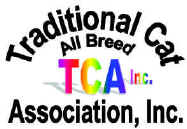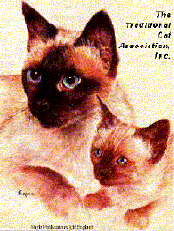|
|
|
THE TRADITIONAL BOMBAY© CAT FAQ's
COPYRIGHT DIANA FINERAN FEBRUARY 7, 2001
HISTORY
I had the exceptional privilege of meeting Nikki Horner of Shawnee Cattery,
Lousiville, KY several years ago and to see some of her cats that began this man
made breed. It was Nikki who set out to create a breed to be a "parlor
panther", which was to be a solid black cat that resembled its larger
cousin the wild panther. No wild blood was used, however, during Nikkiís long
years of dedicated endeavor.
As we chatted about her struggles, I found her to be so enthusiastic, deeply
devoted and totally emersed in her chosen journey. Established in 1945 her
cattery gained a reputation for producing outstanding American Shorthairs,
Burmese, Exotics Shorthairs, Himalayans, Persians and Siamese. Then the idea
struck to create a new breed of a "Burmese" of a different color.
Starting in 1953 she decided to breed a non-pedigreed black Domestic Shorthair
to a Sable Burmese. The resulting kittens grew to have thick coats, but looked
exactly like a poor-quality American Shorthair. Their eye color was not right,
their coats too long and their body type was Ďbig and horsey". Since they
didnít fulfill the form and shape she had in her minds eye, more years were
spent with the Burmese and American Shorthair breeds, trying to develop her
fantasy into a real animal. Finally a pedigreed black American Shorthair,
female, Shawnee Obsidian and a Grand Champion Shawnee Cassius Clay, a Sable
Burmese male were mated and the reality of her dream was personified in the
resulting kittens. This was the litter that began the Traditional Bombay breed.
Most of the breeds features come from the Traditional Burmese. Because her new
breed looked like the black leopard of India, she named it after the city of
Bombay. She said, "It just sort of fell into place."
As is the challenge of any breeder, Nikki went through the difficult process
of selective breeding to make her creation breed true consistently. The by
product was kittens who had to be spay, neutered and found homes, as they didnít
fit the mold. Between 1966 and 1972 27 Traditional Bombay litters (106 kittens
total) were produced. Friends of friends or friends were recruited to provide
homes for the little black cats, who were not acceptable breeding candidates of
a breed that wasnít accepted at the time. Nikki wrote in her breed profile in
the November 1991 Cat Fanciersí Almanac, "Cat breeding to me is an
artistic endeavor. You could say all breeders are artists striving for a living
masterpiece of fur."
It took years to finally get the breed to have harmony of parts and features.
Eventually the ideal look she wanted was achieved. She got totally black cats,
with short, polished, shiny coats, large copper eyes, and their own body and
head shapes. This made them separate and distinct from any other black cat. She
nick named her invention the, "Patent-Leather Kids With The New-Penny
Eyes".
Eighteen years after her first Traditional Bombay breeding Nikki Horner
achieved acceptance of her breed in 1976. By 1980 most of the cat associations
had accepted her breed. Glibly she commented to me, "If I knew it was going
to take so long, I wouldnít have tried it in the first place." In another
interview she is quoted saying, "It took a long time, I never really
realized how much work Iíd have to do. If I had, I wouldnít have done it,
But now Iím glad I did." We discussed the usual politics in the other cat
associations and how it bars progress with healthy, long lived breeds. She
commented about how much outright abuse she endured from the other cat
associations. The breed was attacked with such comments as, "It was a joke
in the cat fancy", "a CFA all-breed Judge said, "Donít waste
your time", "the breed was awful, hopeless, irredeemable". In
fact, for a while Nikki took a break from showing to ease the stress and tension
she was put under. All in all she prevailed and went on to enjoy showing her
Traditional Bombays. She purchased a sister to "Road of Fameís Luv It
Black" and showed that Traditional Bombay to 22nd. Best Cat in
1988.
In 1992 Nikki Horner made this prophetic statement, "Even with all the
cats and wins Iíve had through the years, when Iím gone nobodyís going to
remember. But the Bombay will still be here." Nikki passed away a few years
ago. Even though others may be involved with the breed, we at TCA, Inc. give
full recognition to Nikki Horner, the originator of this most admired breed.
PERSONALITY
Did you always want to own a panther, then the Traditional Bombay is for you.
Since they are extremely agile and intelligent, they can be leash trained,
naturally fetch and love to guard their home. Being affectionate, gentle, easy
going, loving, and sweet natured, this is a very endearing breed. As long as it
is positive, they are agreeable to just about any suggestion from their human
companions. Curiosity and devotion makes them enjoy playing with their preferred
person, yet they are not overly active or verbal. They take a very common sense
attitude toward life with the ability to get their feelings across when they
have something to say.
Their craving for constant companionship and attention makes them follow
their chosen person everywhere to get it. Any nap on your part, finds your lap
occupied by your cuddly Traditional Bombay, purring loudly, gazing into your
eyes soulfully, paws kneading gently. They are nose rubbers and head bumpers,
who love to be held and enjoy being cradled. You wonít be lonely with a
Traditional Bombay.They are not aloof or independent.
Toys are greatly enjoyed and certainly get a work out. But their best love is
to play with people. They play gently. Unlike other cats, who just pull and tear
a toy apart, the Traditional Bombayís toys usually last for several months.
An easy-going nature allows them to get along with almost any cat and most
dogs. All in all they do prefer the company of people most. Even strangers to
the household receive their "hog the stage", "pay me
attention" approach.
The Traditional Bombay is a harmony of the laid-back, even-tempered style of
the American Shorthair and the slightly talkative, playful, very smart Burmese.
Tight coats make them desirable as totally indoor cats.
HEALTH
The Traditional Bombay is exceptionally hardy.
The crossings back to the original two breeds (Burmese & Black American
Shorthair) still used today to keep the breed healthy and to avoid genetic
problems, creates a balancing act for breeders. When a black American Shorthair
is bred to a Sable Burmese, all of the kittens will be black but will carry the
recessive sable gene. If both parents carry the sable gene, about 25 % of the
Traditional Bombay kittens will be born sable brown. Since the Breed Standard
calls for black color only, these sable brown kittens canís be considered
"Burmese" or "Bombays". Body type also gets effected.
Breeding back to the American Shorthair often produces kittens with an American
Shorthair body type, rather than the preferred Traditional Burmese style. The
nose is often too long and the body not compact enough. The American Shorthair
influence also thickens the coat too. These difficulties can be discouraging to
a breeder, which may account for the rarity of Traditional Bombays.
Tragically the very same degeneration of the breed has been done to the
Traditional Bombay as has been done to the Burmese, Persian and Himalayan
breeds. All of the other cat associations have changed this very normal looking
breed into a pug nosed, smushed faced, deformed cat. When contemporary/extreme
Burmese are used Thiamine deficiency, heart disease, and cranial deformities are
among the genetic problems that creep in. TCA, Inc. does not support this
faction of the Traditional Bombay breed.
|
|
|

 The
Traditional Cat Association,
Inc.©1987ģTM
Official Website
The
Traditional Cat Association,
Inc.©1987ģTM
Official Website